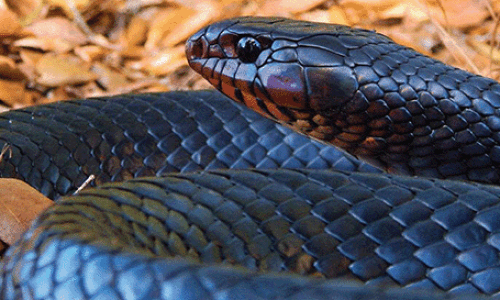By: Kara Tyler-Julian
In Southwest Florida, with our warm subtropical climate, our native ecosystems support many species of snakes. The vast majority of the snakes that we encounter in this area are non-venomous and not dangerous to humans or pets, with only 4 species of venomous species found in the area. Unfortunately, many people moving here from other places are unfamiliar with our native snake species and operate under the assumption that “the only good snake is a dead snake”.
In writing these articles about our native wildlife, I am hoping I can convince a few people to think differently about snakes and other commonly-maligned wildlife.
The Eastern Indigo snake (Drymarchon corais couperi) is one of our many beautiful native snake species and might be the most beautiful if you ask this biologist. If you ever happen upon one, consider yourself extremely lucky as these are rarely encountered and extremely docile. This absolute gem of a snake is ready for a formal occasion, being stylishly dressed in all black with an iridescent sheen and is commonly confused with the more common and also non-venomous, Southern Black racer. However, there are a few differences to look for to determine which snake you are seeing. The Eastern indigo snake will have a reddish coloring on the chin area, whereas the black racer has a white coloring on the chin and is significantly smaller than the Eastern Indigo with a much worse attitude. The Eastern Indigo is the longest snake in North America, reaching lengths of 8-9 feet.
This threatened species of snake inhabits pine flatwoods, hammocks, hardwood forests and the edges of cypress swamps. They have a varied diet that can include insects, small reptiles, amphibians, and mammals, birds, and even other snakes. Of course one of their prey items is rodents such as rats, so just like our other species of native snakes, they are an important natural rat control. These non-aggressive reptiles especially rely on gopher tortoises, as they will utilize the gopher tortoise burrows for shelter and as a place to lay their eggs. They are just one of the hundreds of species that use the burrows created by our native tortoises, further supporting the need to protect the gopher tortoises and their burrows.
Eastern Indigo populations are threatened for many reasons including, but not limited to: capture for the pet trade, habitat destruction and fragmentation, vehicle strikes, parasites spread by invasive pythons, and of course intentional killing by people due to fear and miseducation. Being a predator makes these gorgeous creatures an indicator of ecosystem health and the absence of these and other predatory animals indicates an ecosystem that is not in balance. So, if you are lucky enough to see this or any other native snake species, know that you are likely in an area with a balanced ecosystem and appreciate the natural diversity of our native snake species the role they play.
Visit the Calusa Nature Center and Planetarium at 3450 Ortiz Avenue in Fort Myers to see one of the largest Eastern Indigo snake specimens in their live native animal teaching exhibit.








